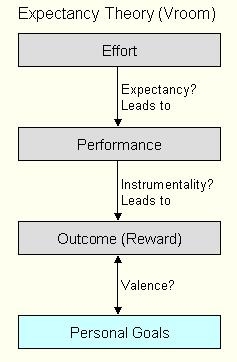The expectancy theory says that individuals have different sets of goals and can be motivated if they have certain expectations. This theory is about choice, it explains the processes that an individual undergoes to make choices. In organizational behavior study, expectancy theory is a motivation theory first proposed by Victor Vroom of the Yale School of Management in 1964.
Motivation, according to Vroom. boils down to the decision of how much effort to apply in a specific task situation. This choice is based on a two-stage sequence of expectations (effort —> performance and performance —> outcome). First, motivation is affected by an individual’s expectation that a certain level of effort will produce the intended performance goal. For example, if you do not believe increasing the amount of time you spend studying will significantly raise your grade on an exam, you probably wilt not study any harder than usual. Motivation also is influenced by the employee’s perceived chances of getting various outcomes as a result of accomplishing his or her performance goal. Finally, individuals are motivated to the extent that they value the outcomes received.
Vroom used a mathematical equation to integrate these concepts into a predictive model of motivational force or strength. For our purposes, however, it is sufficient to define and explain the three key concepts within Vroom’s model—expectancy, instrumentality, and valence.
The expectancy theory says that individuals have different sets of goals and can be motivated if they have certain expectations.
EXPECTANCY THEORY EXPECTATIONS
***There is a positive correlation between efforts and performance,
***Favorable performance will result in a desirable reward,
***The reward will satisfy an important need, he desire to satisfy the need is strong enough to make the effort worthwhile. Vroom’s Expectancy Theory is based upon the following three beliefs.
EXPECTANCY THEORY BELIEFS
1. Valence. Refers to the emotional orientations which people hold with respect to outcomes [rewards]. The depth of the want of an employee for extrinsic [money, promotion, free time, benefits] or intrinsic [satisfaction] rewards. Management must discover what employees appreciate.
2. Expectancy. Employees have different expectations and levels of confidence about what they are capable of doing. Management must discover what resources, training, or supervision the employees need.
3. Instrumentality. The perception of employees whether they will actually receive what they desire, even if it has been promised by a manager. Management must ensure that promises of rewards are fulfilled and that employees are aware of that.
Vroom suggests that an employee’s beliefs about Expectancy, Instrumentality, and Valence interact psychologically. In this way they create a motivational force, such that the employee will act in a way that brings pleasure and avoids pain. This force can be ‘calculated’ via a formula:
EXPECTANCY THEORY FORMULA Motivation = valence x Expectancy (instrumentality)
This formula can be used to indicate and predict things as: job satisfaction, occupational choice, the likelihood of staying in a job, and the effort that one might expend at work.


 Follow
Follow